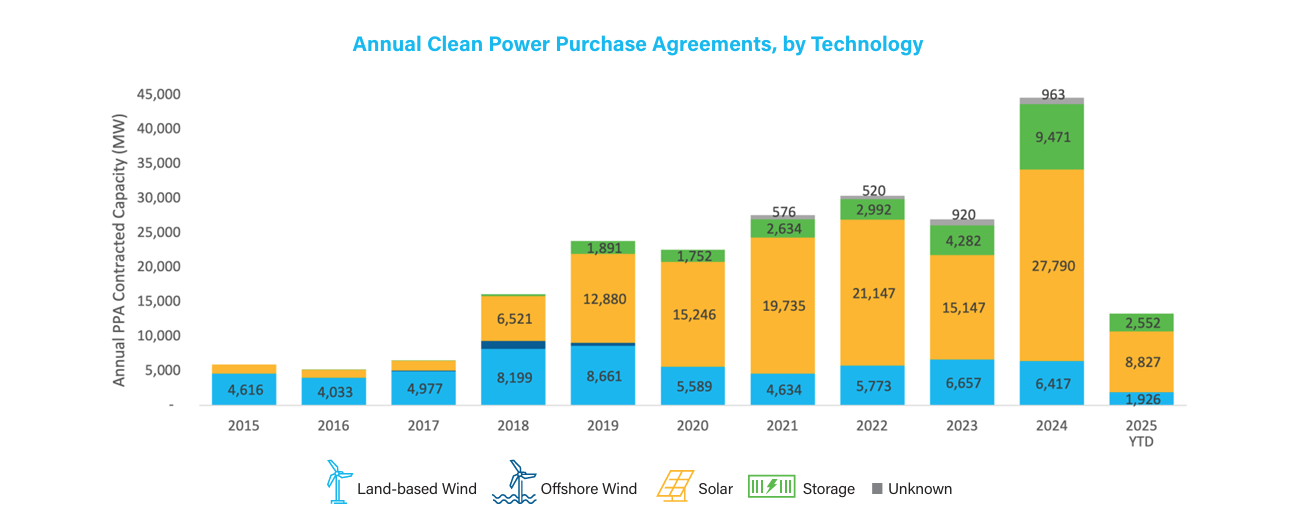REPORT: Federal Chaos Sparks Warning Signs for Clean Energy Investment, According to Q2 Data
Sep 3 2025

WASHINGTON, D.C., September 3, 2025 – The American Clean Power Association (ACP) released its Clean Power Quarterly Market Report today, showing U.S. developers deployed over 11 gigawatts (GW) of new utility-scale solar, wind, and energy storage capacity worth $15.2 billion in investment in Q2 of 2025. While this brings the total operating capacity of clean power in the U.S. to over 332 GW, it represents less than a 1% increase over Q2 2024 amidst concerning signs for the industry. The clean power development pipeline showed virtually no growth (expanding by less than 100 MW to 184.5 GW), solar installations declined 23% in the first half of 2025, and Power Purchase Agreements (PPAs) plummeted—early indicators of federal policy attacks and fluctuating trade policy undermining American energy security and economic growth.
“America’s clean energy industry continues to add much needed power to the grid. Unfortunately, federal policy obstacles and restrictive mandates are threatening hundreds of billions in planned energy investment,” said ACP CEO Jason Grumet. “The uncertainty created by new bureaucratic delays and unclear demands is having a chilling effect on the pipeline for future energy projects, stalling growth precisely when our nation needs more energy to power a growing economy.”
Stable Policy Environment Necessary for Investment
Federal policy actions from nearly every department and an unstable tariff environment have led to a drop in clean power purchasing and planning for the future—despite skyrocketing demand nationwide. The first half of 2025 saw 32% less capacity being contracted through PPAs than the first half of 2024. Battery storage PPA announcements were down 88% from Q1 to Q2, with wind announcements down 93%. Corporate wind and solar PPA prices also surged 6% quarter-over-quarter, and 8% year-over-year, reflecting the instability of the purchasing environment. Immense industry uncertainty led to stalled growth of procurements during the second quarter of 2025 compared to the previous quarter, as developers and purchasers awaited further clarity on changes to tax credit guidance and attempted to budget with shifting trade agreements.
Key Highlights
- Total Installed Capacity: As of June 30, the U.S. had 330+ GW of clean power capacity in operation, enough to power more than 81 million homes.
- Procurement Falls Dramatically: The first half of 2025 saw a 32% decrease in capacity being contracted through PPAs compared to the first half of 2024. Other types of agreements are down 48%, compared to the first half of 2024.
- Project Pipeline Growth Stagnates: The clean power pipeline sat at 184,500 MW at the end of Q2, up only 100 MW from the end of the first quarter of 2025.
- Storage Continues to Climb: Developers added over 6.5 GW in the first half of 2025, 63% more than the first half of 2024.
- Construction Goes Forward: At midyear 2025, developers reported that 83,403 MW of projects were under construction, spanning 580 projects. Construction activity was highest in Texas (21 GW) followed by Arizona (7.8 GW), California (7.2 GW), New Mexico (4.8 GW) and Wyoming (4.1 GW).
- Major Growth in Arizona: Arizona became the latest state to surpass 10 GW of clean power installed, after adding 1,220 MW of new solar capacity and 1,369 MW of new storage capacity in the quarter. The state now hosts the third-largest storage fleet and fifth-largest utility-scale solar capacity in the country, as well as the second-largest clean power pipeline after Texas.
- States Rely on Solar: Texas, Indiana, Arkansas, Kansas, and Michigan added mostly new solar, while Illinois was the only state in the quarterly top ten to add mostly wind capacity.
- Power Doesn’t Need to be Political: Eight of the top ten states for Q2 clean power additions voted Republican in the most recent presidential election.
Clean Energy Keeps Utility Bills Affordable and Power Reliable
“Clean energy is the fastest-to-deploy energy resource. With demand for electricity at historic highs, Americans cannot afford policies that limit power production and raise household electricity bills,” added Grumet. “The U.S. must support all forms of energy.”
A public version of the report is available on the ACP website, with the full report and underlying datasets available exclusively to ACP members.